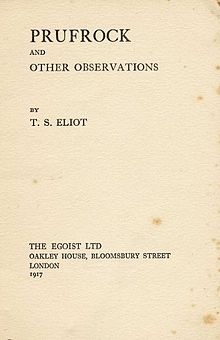
Back أغنية حب جيه. ألفرد بروفروك Arabic Canción de amor de J. Alfred Prufrock Spanish J. Alfred Prufrocki armulaul Estonian La Chanson d'amour de J. Alfred Prufrock French It Leafdesliet fan J. Alfred Prufrock Frisian Il canto d'amore di J. Alfred Prufrock Italian Любовная песня Дж. Альфреда Пруфрока Russian J. Alfred Prufrocks kärlekssång Swedish Bản tình ca của J. Alfred Prufrock Vietnamese
| The Love Song of J. Alfred Prufrock | |
|---|---|
| by T. S. Eliot | |
 Cover page of The Egoist, Ltd.'s publication of Prufrock and Other Observations (1917) | |
| Original title | Prufrock Among the Women |
| First published in | June 1915 issue of Poetry[2] |
| Country | United States |
| Language | English |
| Publisher | magazine (1915): Harriet Monroe chapbook (1917): The Egoist, Ltd. (London)[1] |
| Lines | 140 |
| Pages | 6 (1915 printing)[2] 8 (1917 printing)[1] |
| Full text | |
"The Love Song of J. Alfred Prufrock", commonly known as "Prufrock", is the first professionally published poem by American-born British poet T. S. Eliot (1888–1965). The poem relates the varying thoughts of its title character in a stream of consciousness. Eliot began writing "Prufrock" in February 1910, and it was first published in the June 1915 issue of Poetry: A Magazine of Verse[2] at the instigation of fellow American expatriate Ezra Pound. It was later printed as part of a twelve-poem chapbook entitled Prufrock and Other Observations in 1917.[1] At the time of its publication, "Prufrock" was considered outlandish,[3] but the poem is now seen as heralding a paradigmatic shift in poetry from late 19th-century Romanticism and Georgian lyrics to Modernism.
The poem's structure was heavily influenced by Eliot's extensive reading of Dante Alighieri[4] and makes several references to the Bible and other literary works—including William Shakespeare's plays Henry IV Part II, Twelfth Night, and Hamlet; the poetry of seventeenth-century metaphysical poet Andrew Marvell; and the nineteenth-century French Symbolists. Eliot narrates the experience of Prufrock using the stream of consciousness technique developed by his fellow Modernist writers. The poem, described as a "drama of literary anguish", is a dramatic interior monologue of an urban man stricken with feelings of isolation and an incapability for decisive action that is said "to epitomize [the] frustration and impotence of the modern individual" and "represent thwarted desires and modern disillusionment".[5]
Prufrock laments his physical and intellectual inertia, the lost opportunities in his life, and lack of spiritual progress, and is haunted by reminders of unattained carnal love. With visceral feelings of weariness, regret, embarrassment, longing, emasculation, sexual frustration, a sense of decay, and an awareness of aging and mortality, "Prufrock" has become one of the most recognized voices in modern literature.[6]
- ^ a b c Eliot, T. S. Prufrock and Other Observations (London: The Egoist, Ltd., 1917), 9–16.
- ^ a b c Eliot, T. S. "The Love Song of J. Alfred Prufrock" in Monroe, Harriet (editor), Poetry: A Magazine of Verse (June 1915), 130–135.
- ^ Eliot, T. S. (21 December 2010). The Waste Land and Other Poems. Broadview Press. p. 133. ISBN 978-1-77048-267-8. Retrieved 9 July 2017. (citing an unsigned review in Literary Review. 5 July 1917, vol. lxxxiii, 107.)
- ^ Hollahan, Eugene (March 1970). "A Structural Dantean Parallel in Eliot's 'The Love Song of J. Alfred Prufrock'". American Literature. 1. 42 (1): 91–93. doi:10.2307/2924384. ISSN 0002-9831. JSTOR 2924384.
- ^ McCoy, Kathleen; Harlan, Judith (1992). English Literature From 1785. London, England: HarperCollins. pp. 265–66. ISBN 006467150X.
- ^ Bercovitch, Sacvan (2003). The Cambridge History of American Literature. Vol. 5. Cambridge, England: Cambridge University Press. p. 99. ISBN 0521497310.
© MMXXIII Rich X Search. We shall prevail. All rights reserved. Rich X Search